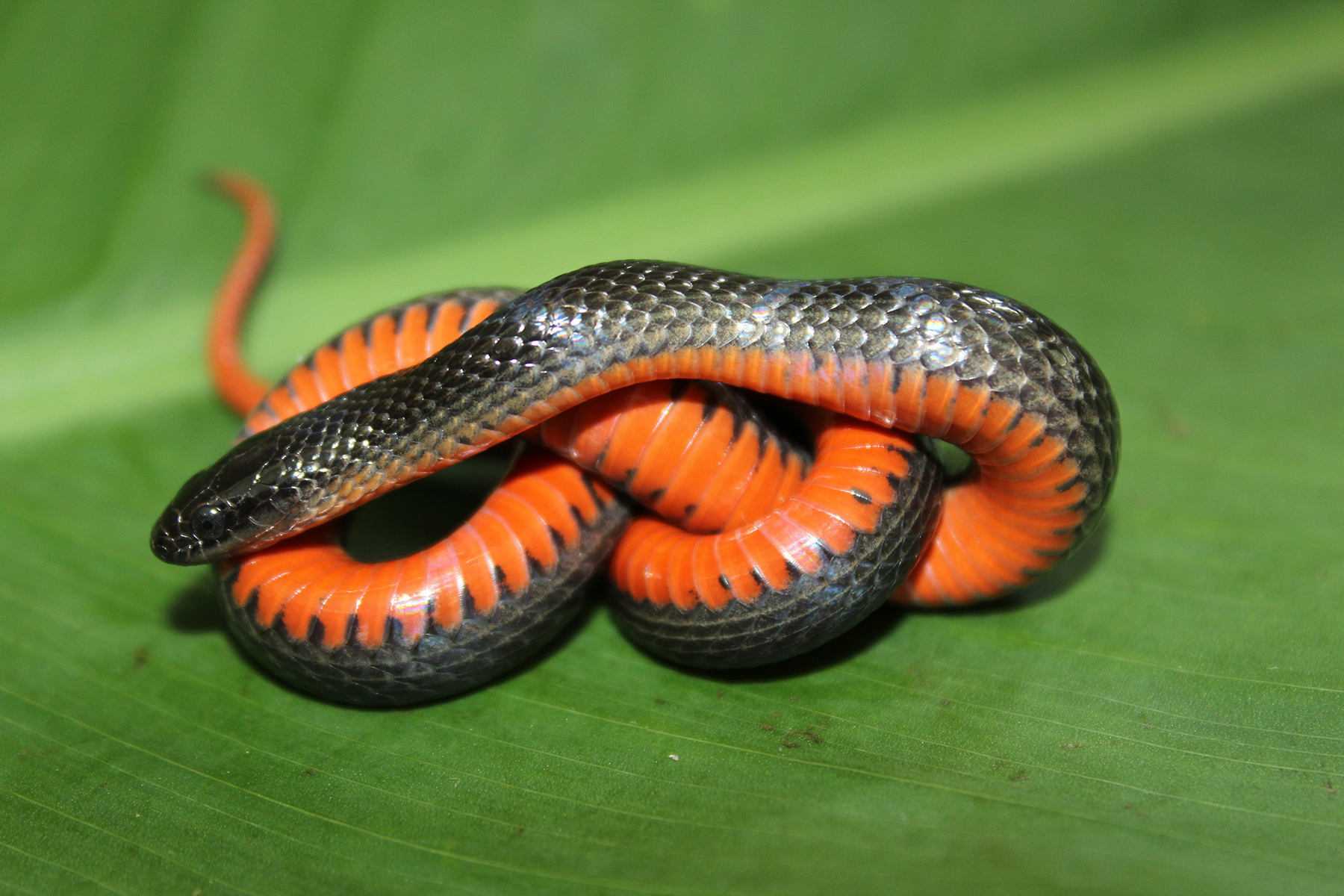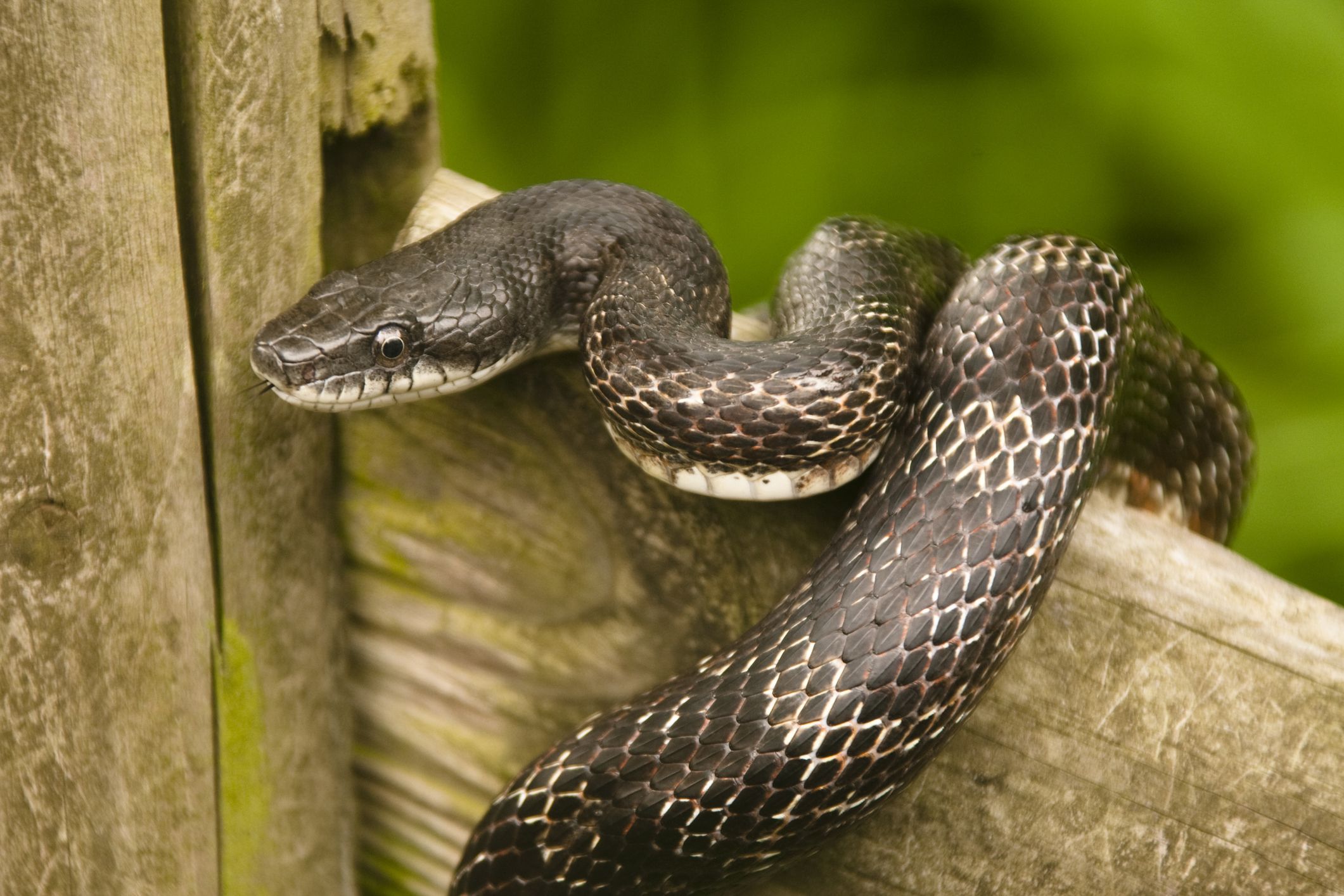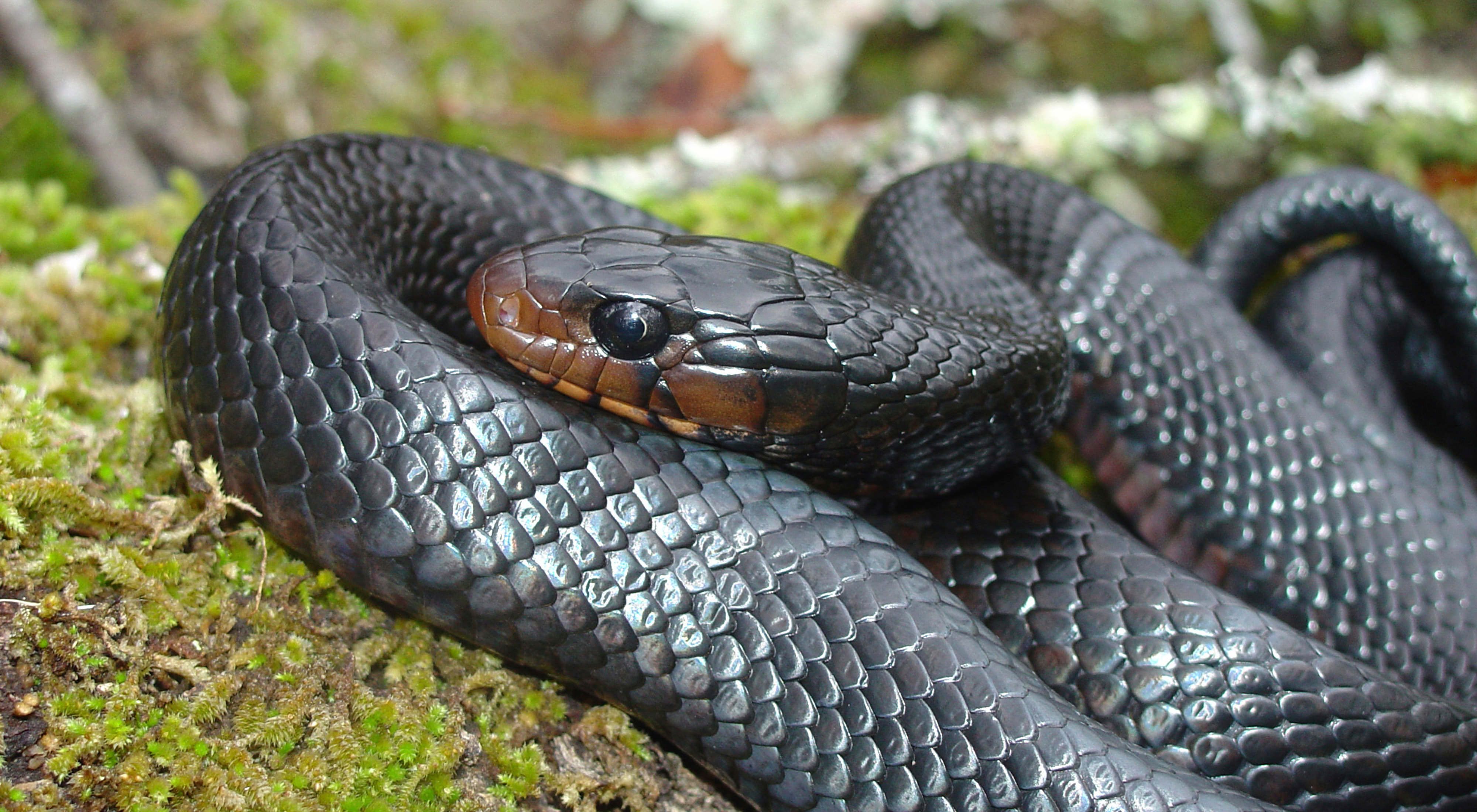Black snakes are a group of snakes that are either entirely black or mostly black in color. There are several species of black snakes, and some of them are difficult to identify for those inexperienced with snakes.
Scientifically and taxonomically speaking, black snakes are those which belong to the Pseudechis genus, and there are nine such snake species in this genus. However, there are other snakes with the descriptor “black” in their name, which also belong to different categories.
You are reading: 9 Types Of Black Snakes
In this article, we will focus on the nine species of black snakes in the Pseudechis genus and other common black snakes found in the southeastern United States. We will also discuss their identification, ecology, and behavior.

9 Types Of Black Snakes
Black Rat Snake

The black rat snake, also known as the eastern rat snake, is a non-venomous constrictor that is native to the central and eastern United States. Here are some interesting facts about black rat snakes:
– Appearance: Black rat snakes are large snakes that can grow up to 7 feet long. They have shiny black scales on their back and a light-colored belly, and their throat and chin are white. The head of an eastern rat snake is wider than the neck and the rest of the body.
– Habitat: Black rat snakes live in fields, woodlands, farmlands, and around suburban communities from Connecticut to South Carolina and west to the middle of Kansas and Oklahoma.
– Diet: Adult black rat snakes primarily eat mice, rats, squirrels, and birds, as well as bird eggs. They are a common predator on wood duck eggs.
– Behavior: Black rat snakes are excellent climbers and spend much of their time in trees. They also tend to seek shelter in rock outcroppings and stone walls, and may be found in the vicinity of barns, abandoned buildings, and trash piles, presumably hunting for rodents. When approached, black rats usually remain motionless. With their cryptic black coloration, they become invisible against the bark or dark forest floor.
– Conservation: The black rat snake is considered stable throughout its range.
– Identification: Most confusion in black rat snake identification is due to the juvenile pattern. Baby or juvenile snakes have a gray and black pattern of scales.
Black rat snakes are an important part of the ecosystem, as they help control rodent populations.
Black Kingsnake
The black kingsnake is a non-venomous constrictor that belongs to the Lampropeltis genus. Here are some interesting facts about black kingsnakes:
Appearance:
– Black kingsnakes are moderate to stocky black snakes, with small yellowish spots on the head and back.
– The belly of black kingsnakes has a black and white checkered pattern.
– Their head is not distinct from their neck, and their scales are smooth and shiny.
– Adult black kingsnakes may reach up to 4 feet in total length, although most individuals are smaller.
Habitat:
– Black kingsnakes are found in a variety of habitats, including forests, fields, shrubby areas, forest edges, and urban areas.
– They are frequently found in cleared areas that are overgrown, such as fields, clearings, or abandoned areas.
– They inhabit deserts, chaparral, and woodlands.
Diet:
– Black kingsnakes are constrictors and often prey upon other snakes, including venomous pit vipers.
– Apparently, black kingsnakes are immune to pit viper venom.
Behavior:
– Black kingsnakes breed in the spring, and females deposit eggs in moist areas during the early summer.
– Hatchlings are often found in late summer or early fall.
– Black kingsnakes are active during the day and at night, and they tend to hunt during the daytime, as they rely on their (albeit limited) vision for predation.
– While their eyes do have severely limited acuity, their ability to sense heat allows them to locate prey.
Black kingsnakes are commonly kept as pets, as they are easy to care for and generally well-natured.
Southern Black Racer
The southern black racer (Coluber constrictor priapus) is a subspecies of the nonvenomous Coluber constrictor snake species that is commonly found in the southeastern United States. Here are some interesting facts about the southern black racer:
Appearance:
– Southern black racers are long and slender snakes that can grow up to 6 feet in length.
– Adults are black or bluish-black with white or whitish markings on the chin and throat.
– Juveniles are gray with distinct reddish-brown blotches running down the back of the head and body.
Habitat:
– Southern black racers occupy a wide variety of habitats, such as pine flatwoods, hardwood hammocks, prairies, sandhills, scrub, cypress strands, melaleuca forests, and limestone outcroppings.
– They are often found in suburban neighborhoods where development encroaches into favorable habitats.
Diet:
– Southern black racers are predators that rely on lizards, insects, moles, birds, eggs, small snakes, rodents, and frogs.
– They are active hunters and are known for their speed and agility.
Behavior:
– Despite their name, southern black racers do not coil around their prey in typical constrictor fashion.
– Instead, they are more likely to suffocate or crush their victim into the ground.
– Southern black racers are nonvenomous and are not a threat to humans.
– They are often mistaken for the venomous cottonmouth, also known as the water moccasin, due to their similar appearance.
– Natural enemies of southern black racers include birds of prey such as hawks, including the red-shouldered hawk.
Southern black racers are an important part of the ecosystem, as they help control rodent and insect populations.
Eastern Indigo Snake

The eastern indigo snake (Drymarchon corais couperi) is a species of large, non-venomous snake in the family Colubridae. It is native to the southeastern United States and is the longest native snake species in the country, reaching lengths of almost 9 feet.
Here are some interesting facts about the eastern indigo snake:
Appearance:
– The eastern indigo snake has uniform blue-black dorsal scales, with some specimens having a reddish-orange to tan color on the throat, cheeks, and chin.
– This snake received its common name from the glossy iridescent dorsal and ventral scales which can be seen as blackish-purple in bright light.
– Most indigo snakes have smooth scales, although adults do have keels (ridges) on the front of some of their scales.
Habitat:
– The eastern indigo snake inhabits areas from far southwestern South Carolina through Florida, and west to southern Alabama and southeastern Mississippi.
– They are widely distributed throughout central and south Florida but primarily occur in sandhill habitats in northern Florida and southern Georgia.
– Eastern indigo snakes are not commonly found in great numbers in the wetland complexes of the Everglades, though their range extends south to the Florida Keys.
Diet:
– The eastern indigo snake’s diet primarily consists of a variety of species, including small mammals, birds, toads, frogs, turtles and their eggs, lizards, and small alligators.
– They are active hunters and are known for their ability to eat venomous snakes, such as rattlesnakes and cottonmouths.
Behavior:
– When approached, the eastern indigo snake shows no aggression.
– They are also exothermic species – their body temperature is externally regulated.
– Parthenogenesis (a form of asexual reproduction) may also be possible with eastern indigo snakes, as some virginal snakes have been seen laying eggs.
The eastern indigo snake is an important species in the southeastern United States, and its conservation is a priority for many organizations.
Black Swampsnake
The black swampsnake (Liodytes pygaea) is a species of snake in the subfamily Natricinae of the family Colubridae. Here are some interesting facts about the black swampsnake:
Appearance:
– Black swampsnakes are small, shiny, and black snakes with smooth scales.
– They have a bright red or reddish-orange belly.
– Most adult black swampsnakes are about 10-15 inches (25-38 cm) in total length, although the largest recorded specimen was 55 inches (140 cm) long.
Habitat:
– Black swampsnakes prefer heavily vegetated swampland habitats.
– They are found in the southeastern United States, including the states of North Carolina, South Carolina, Georgia, Alabama, and Florida.
Diet:
– Black swampsnakes are highly aquatic and feed on small fish, frogs, and salamanders.
Behavior:
– Black swampsnakes are non-venomous and are not a threat to humans.
– They are active during the day and at night, and they tend to be more active during the warmer months.
The black swampsnake is an important species in the southeastern United States, as it helps control populations of small aquatic animals.
Eastern Ratsnake
The eastern ratsnake, also known as the black ratsnake, is a species of nonvenomous snake in the family Colubridae. Here are some interesting facts about the eastern ratsnake:
Appearance:
– Eastern ratsnakes are large nonvenomous snakes that can grow up to 7 feet in length.
– They have shiny black scales on their back and a light-colored belly, and their throat and chin are white.
– The head of an eastern ratsnake is wider than the neck and the rest of the body.
Habitat:
– Eastern ratsnakes live in fields, woodlands, farmlands, and around suburban communities from Connecticut to South Carolina and west to the middle of Kansas and Oklahoma.
– They are commonly found in pinelands, hardwood hammocks, cypress strands, swamps, marshes, prairies, and agricultural fields in Florida.
Diet:
– Eastern ratsnakes are active hunters and feed on small mammals, birds, and their eggs, as well as lizards, frogs, and other snakes.
Behavior:
– Eastern ratsnakes are nonvenomous and are not a threat to humans.
– They are active during the day and at night, and they tend to be more active during the warmer months.
– When threatened, eastern ratsnakes may vibrate their tails, hiss, and strike, but they are not aggressive and will usually try to escape if given the opportunity.
Eastern ratsnakes are an important part of the ecosystem, as they help control rodent and bird populations.
Southern Ring-Necked Snake
Read more : 11 Types Of Sharks That Went Extinct
The southern ring-necked snake (Diadophis punctatus) is a species of small, nonvenomous snake in the family Colubridae. Here are some interesting facts about the southern ring-necked snake:
Appearance:
– Southern ring-necked snakes are small, slender snakes that typically grow to be about 10-15 inches (25-38 cm) in total length.
– They have a black or slate gray body with a yellow, cream, or orange ring around their neck.
– The neck ring may be incomplete, and snakes in the Lower Florida Keys may lack a ring entirely.
– The belly of southern ring-necked snakes is bright yellow, orange, or red with a single row of black half-moon markings down the center.
Habitat:
– Southern ring-necked snakes are found throughout much of the United States, central Mexico, and southeastern Canada.
– They prefer dry habitats in the forest, such as on roadcuts and exposed rocky areas in the mountains.
Diet:
– Southern ring-necked snakes are nocturnal predators and feed primarily on small lizards, snakes, salamanders, frogs, toads, earthworms, slugs, and insects.
– They are not constrictors, and they immobilize larger prey using a mildly toxic venom that is delivered by two slightly elongated teeth at the rear of the mouth.
Behavior:
– Southern ring-necked snakes are nonvenomous and are not a threat to humans.
– When threatened, they may curl up their tails and expose their bright red-orange posterior, ventral surface.
– Southern ring-necked snakes are secretive and nocturnal, so they are rarely seen during the day.
Southern ring-necked snakes are an important part of the ecosystem, as they help control populations of small animals such as insects and slugs.
Red-Bellied Mudsnake
The red-bellied mudsnake (Farancia abacura) is a species of nonvenomous, semiaquatic, colubrid snake that is native to the southeastern United States. Here are some interesting facts about the red-bellied mudsnake:
Appearance:
– Red-bellied mudsnakes are large, thick-bodied snakes that can grow up to 80 inches (203 cm) in total length, although most individuals are smaller.
– They have a shiny black upper body and a red underside crossed with black bands.
– The red irregularly extends onto the lower sides of the snake.
– The head is rounded and not distinct from the neck, and the eyes are small and located on the top of the head.
Habitat:
– Red-bellied mudsnakes prefer swampy, heavily vegetated habitats and muddy bottoms and banks.
– They are occasionally found in brackish tidal creeks or bays.
– Red-bellied mudsnakes are typically found in stagnant, muddy waters of shallow streams, rivers, and swamps.
Diet:
– Red-bellied mudsnakes primarily feed on fish, but they also eat amphibians, crayfish, and other aquatic invertebrates.
Behavior:
– Red-bellied mudsnakes are nonvenomous and are not a threat to humans.
– When threatened, they may flatten their bodies and hiss loudly.
– Red-bellied mudsnakes are active during the day and at night, and they tend to be more active during the warmer months.
Red-bellied mudsnakes are an important part of the ecosystem, as they help control populations of small aquatic animals such as fish and crayfish.
Black Pinesnake
The black pinesnake (Pituophis melanoleucus lodingi) is a subspecies of the nonvenomous pine snake (Pituophis melanoleucus) in the family Colubridae. Here are some interesting facts about the black pinesnake:
Appearance:
– Black pinesnakes are large, stocky snakes that can grow up to 89 inches (226 cm) in total length.
– They have a uniform black or dark brown color on their back and belly.
– The scales on their back are keeled, which gives them a rough texture.
– Black pinesnakes have a triangular head and a pointed tail.
Habitat:
– Black pinesnakes are found in the southeastern United States, primarily in Alabama and Mississippi.
– They prefer pine savannas and pine forests with sandy soils.
Diet:
– Black pinesnakes are active hunters and feed on small mammals such as rats, mice, and moles, as well as eggs.
– They often enter rodent burrows in search of prey, and multiple kills are frequent, with the snake pressing the mice against the walls of the burrow.
Behavior:
– Black pinesnakes are nonvenomous and are not a threat to humans.
– They are active during the day and at night, and they tend to be more active during the warmer months.
– Black pinesnakes are federally protected under the Endangered Species Act.
The black pinesnake is an important species in the southeastern United States, and its conservation is a priority for many organizations.
FAQS
1. What is a black snake?
Black snakes are a group of snakes that are either entirely black or mostly black in color. Scientifically and taxonomically speaking, black snakes are those which belong to the Pseudechis genus, and there are nine such snake species in this genus. However, there are other snakes with the descriptor “black” in their name, which also belong to different categories.
2. Are black snakes venomous?
Most black snakes are nonvenomous and are not a threat to humans. However, there are some venomous snakes that are black, such as the black mamba.
3. What do black snakes eat?
The diet of black snakes varies depending on the species. Some species, such as the black rat snake and eastern ratsnake, primarily eat rodents, while others, such as the southern ring-necked snake and red-bellied mudsnake, feed on small aquatic animals such as fish and crayfish.
4. Where do black snakes live?
Black snakes are found in a variety of habitats, including fields, woodlands, farmlands, swamps, and suburban communities. The specific habitat depends on the species of black snake.
5. Are black snakes beneficial?
Yes, black snakes are beneficial to the ecosystem, as they help control populations of rodents and other small animals. They are also an important food source for many predators, such as birds of prey.
Source: https://petstutorial.com
Category: Animals










